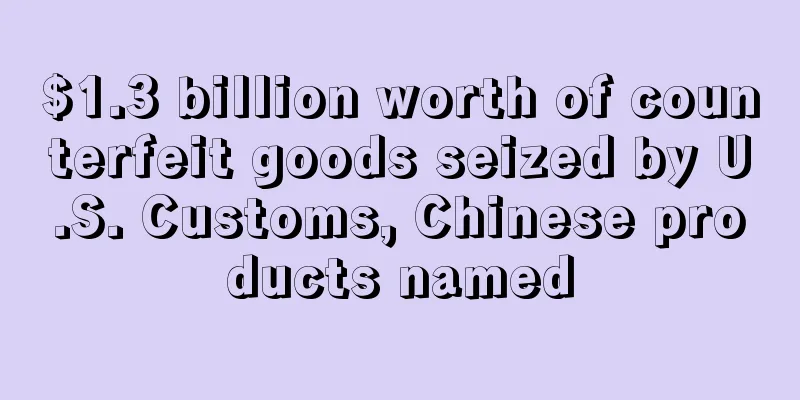$1.3 billion worth of counterfeit goods seized by U.S. Customs, Chinese products named

|
U.S. Customs seizes $1.3 billion in counterfeit goods in 2020
Data shows that in fiscal year 2020, the U.S. Customs seized a total of 26,503 batches of goods, and the total value of these counterfeit goods was as high as US$1.3 billion, which is a terrifying number.
Recently, the U.S. Customs and Border Protection ( CBP) conducted inspections on specific goods, and the focus of the inspection mainly included goods imported specifically from China and Hong Kong, China. According to U.S. Customs officials, this activity was mainly to intercept counterfeit medical equipment and supplies. After inspecting nearly a thousand batches of goods, 25 batches of goods were seized, with a total value of more than $500,000.
Among them, the counterfeit goods mainly include 469 well-known brand sportswear, 163 luxury handbags, sunglasses and electronic products, as well as 25 adulterated drugs and animal vaccines. These goods mainly come from China, Laos, South Korea and other places.
In fact, the rapid development of e-commerce has enabled consumers to easily purchase millions of products through online stores, but this convenient shopping method has also provided a sales channel for counterfeit and pirated goods, which are mainly sold in underground stores and third-party e-commerce websites.
However, many platforms have taken various measures to crack down on sellers who sell counterfeit goods, especially Amazon, which has continuously launched new measures to crack down on counterfeit sellers, but counterfeit goods cannot be eliminated. For this reason, the US Congress also issued a "Comment on the Notorious Market for Counterfeiting and Piracy" and ordered a strict investigation of counterfeit goods on platforms such as Amazon.
Counterfeit goods cost U.S. consumers $100 billion a year
Relevant data shows that the United States loses nearly 100 billion US dollars every year due to counterfeit goods, which is one of the reasons why the U.S. Customs strictly investigates and cracks down on counterfeit goods. These counterfeit goods are mainly popular products, such as smartphones and related accessories, electronic products, clothing, cosmetics, high-end luxury goods and medical supplies.
Sellers may not only face the seizure and surrender of goods, but may also be sued by major brands for product infringement, etc. To this end, the U.S. Customs has also established an education program to educate consumers on the truth behind counterfeit goods and to raise awareness of the consequences and dangers associated with purchasing counterfeit and pirated goods.
Cross-border sellers also need to pay attention. As the US Customs cracks down on counterfeit goods, such actions will be carried out from time to time, and various platforms are gradually starting to clear mines. Sellers must pay attention to it, eliminate counterfeit goods, and avoid skirting the rules in order to win the real market. U.S. Customs China Counterfeit goods |
Recommend
What is FunPinPin? FunPinPin Review, Features
Company Profile FunPinPin is an independent websi...
An employee was caught reselling company goods!
A group of people took risks and cross-border e-c...
What is Desert Farms? Desert Farms Review, Features
Desert Farms is an organic camel milk from the Un...
What is Bind ERP? Bind ERP Review, Features
<span data-docs-delta="[[20,{"gallery"...
Multiple brand trademarks have been preemptively registered? International trademark protection becomes a problem
Factors such as sellers’ internal competition, pl...
What is Tongyue Logistics? Tongyue Logistics Review, Features
Tongyue Logistics provides professional cargo tra...
During the epidemic, food and beverage transactions on the Tokopedia platform surged by 350%!
During the epidemic, residents of various countri...
The Olympic economy has boosted the overseas industry on Alibaba International Station
"The Olympics has a very obvious driving eff...
What is NinjaGram? NinjaGram Review, Features
NinjaGram is the latest social marketing software...
Amazon ranks sixth in the Dutch e-commerce market
Every year, the Dutch magazine Twinkle ranks loca...
AliExpress Russia will launch a separate "Order Fund Management Portal" in batches starting from July 25
Just now, AliExpress Russia announced that in ord...
Canadian online store Ketch Shoes drives personalized shopping experience
In the past year, consumers' shopping experie...
Meiya's hot search word NO.1! Peak season products are booming
The 2023 peak season is here! Entering September ...
Google launches new shopping feature that enables “search and shop”
According to foreign media reports, Google is pla...
A group of sellers suffered again, with their profits a hundred times higher being maliciously extorted!
There are all kinds of birds in the forest. In th...









